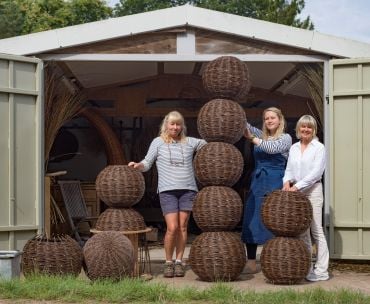
Oxford Vaccine Group marks 30 years battling ‘deadly six’ diseases with major art installation
A major art installation featuring dramatically upscaled bacteria, viruses and a parasite will be unveiled on 26 September at Oxford University’s Museum of Natural History to celebrate 30 years of vaccine development at the Oxford Vaccine Group (OVG) - tackling some of the world’s most deadly diseases.
The installation was commissioned to mark the 30th anniversary of the Oxford Vaccine Group which was established in 1994, and set out to provide scientific research into the development and implementation of vaccines, in particular diseases for which there were at the time no effective vaccines.
The installation consists of six, three-dimensional sculptures woven in English willow, representing different diseases for which OVG has developed a vaccine: pneumonia, meningitis, typhoid, Covid, malaria and Ebola. Five of these will be suspended in the central room of the Museum, within the How Evolution Works gallery, with the sixth – a 2.4m long representation of Ebola weighing 75kg – lying at floor level.

Acclaimed Scottish artist, Angela Palmer, whose sculptures are in museums worldwide, previously created a glass sculpture of the original Wuhan coronavirus particle sphere at 8 million times its size, which was unveiled at the Museum of Natural History and is now on display in London’s Science Museum.
'I had originally planned to use the same technique' explains Palmer, 'However apart from the coronavirus, none of these have been modelled in 3D.'
'I was battling to find an alternative concept' she continues, 'and came across a collection of strange, three-dimensional shapes woven in straw while on holiday. One particularly reminded me of the meningitis bacteria form, and it struck that I could explore creating the entire installation in willow.'
'Willow was immediately appealing to me' Palmer adds. 'It is a native British tree and is imbued with medical associations dating back some 3,500 years.'

Sound will also feature within the installation: Palmer has inserted a speaker into the sculpture representing the malaria parasite, that plays the sinister but familiar high-pitched ‘whine' of one of the most lethal mosquitoes in the world. The sound of the Anopheles Funestus will be played on a loop, pausing 10 seconds every minute to symbolise the fact that today a child under the age of 5 dies of malaria every 60 seconds.
'The Museum of Natural History is both a centre for scientific study at Oxford and a space for the public to engage with science, so we’re delighted to be able to celebrate the success of the Oxford Vaccine Group with this unique meeting of science and artwork' says Rachel Parle, Interim Head of Exhibitions, Oxford University Museum of Natural History.
The installation has been partly funded by the University of Oxford’s Gardens, Libraries and Museums (GLAM) division and will be open to members of the public from 26 September 2024 to 5 January 2025.
Richard Ovenden OBE, Head of GLAM, said: 'We are delighted to be able to support this remarkable installation commemorating Oxford University’s contribution to the war on infection. The Deadly Six will sit alongside an assembly of one of the world’s greatest groupings of cultural and scientific collections.'
'At the Oxford Vaccine Group, we’ve always strived to create a bridge between research and public health advice, and public engagement with vaccines' concludes Pollard. 'So it’s fantastic to have the Museum of Natural history host this exhibit. I’m hopeful that a great many of the public will visit and be able to engage with our work, and with vaccines in a positive way.'
 Expert Comment: Can Europe hold the line of liberal democracies?
Expert Comment: Can Europe hold the line of liberal democracies?
 Oxford launches first human aerosol TB challenge trial
Oxford launches first human aerosol TB challenge trial
 Rees Centre report reveals challenges faced by Black and Asian kinship carers
Rees Centre report reveals challenges faced by Black and Asian kinship carers
 Expert Comment: The Modern Slavery Act at 10 – what have we learnt for human rights?
Expert Comment: The Modern Slavery Act at 10 – what have we learnt for human rights?
 Côte d’Ivoire makes history as first nation to deploy R21/Matrix-M™ Malaria Vaccine
Côte d’Ivoire makes history as first nation to deploy R21/Matrix-M™ Malaria Vaccine
 Shipment of R21 malaria vaccine to Central African Republic marks latest milestone for child survival
Shipment of R21 malaria vaccine to Central African Republic marks latest milestone for child survival